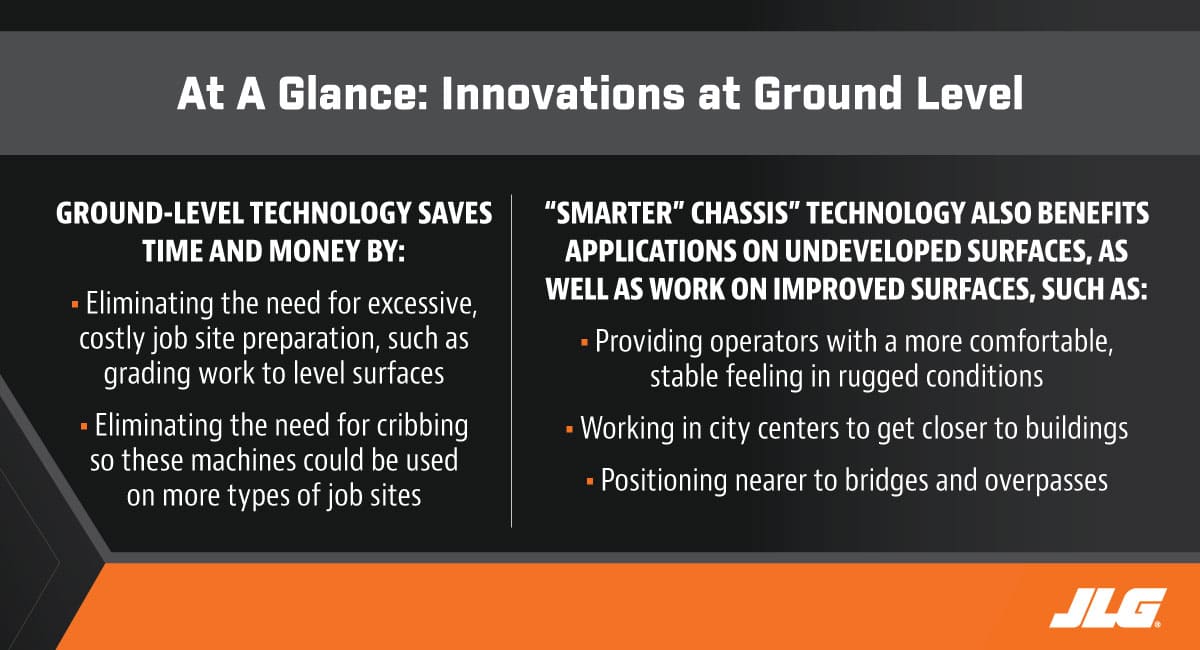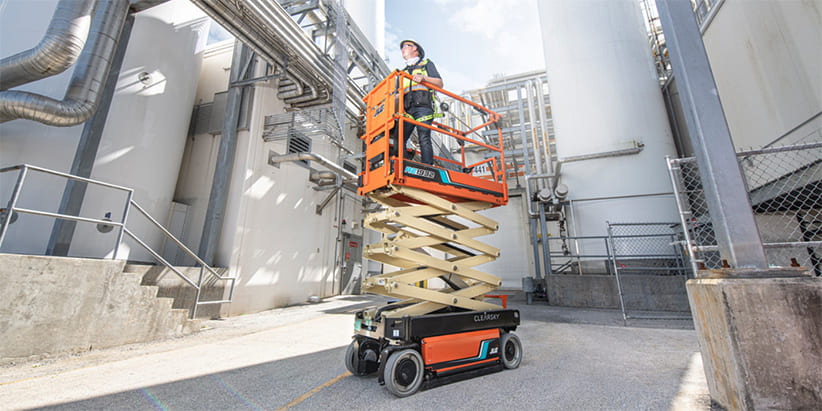“Access equipment designs are going through a significant transformation,” says Ignacy Puszkiewicz, Senior Director of Future Technology and Industrial Design, JLG.
“This new generation of machines looks and operates very differently. It’s no longer about general specification updates. It’s about combining innovation with technology to solve the most common job site challenges, like working on uneven or inclined terrain.”
For example, says Puszkiewicz, many applications and working environments can be rather challenging for an aerial lift with a traditional oscillating axle to work with the boom elevated out from transport position. That’s because these machines are only rated to work on firm, level surfaces (with 5 degrees or less of grade). And, most job sites aren’t flat.

Today’s solutions
According to Puszkiewicz, access original equipment manufacturers (OEMs) are working to overcome traditional machine limitations in different ways. Some OEMs have focused on developing products that reach further and higher, while others have advanced the machine’s control system technology to enable the equipment to work on steeper slopes.
While these advancements are good and have a place in the market, Puszkiewicz believes that the access industry's future will be for OEMs to develop practical technology solutions that are nearer to ground level, introducing the concept of a “smarter” chassis.
New technologies coming to market
“Smarter” chassis technologies will benefit not only general construction applications on undeveloped surfaces but also work on improved surfaces where infrastructure is already established. “Technology can help operators working in city centers that want to get closer to buildings but can’t because of the imbalance in height between the streets, curbs and sidewalks,” says Puszkiewicz.
He adds: “Also, operators working near bridges and overpasses, on job sites which can be extremely limited on space because of ongoing traffic or water obstacles, could benefit from using machines with advanced chassis technology.”
This type of ground-level technology could also save a significant amount of time and money because it would eliminate the need for excessive, costly job site preparation, such as grading work to level surfaces. And, it would eliminate the need for cribbing so these machines could be used on more types of job sites. In turn, the technology would allow machines to work closer to buildings with less positioning while providing operators with a more comfortable, stable feeling when operating in rugged conditions.
Several recent developments in machine chassis technology have been developed that now offer operators new ways to be productive when working on uneven terrain. For instance, variable-tilt and self-leveling technologies are designed to adjust a machine’s capability under certain conditions to the ground or surface being worked on.
Variable tilt
Variable-tilt technology is currently used in slab scissor lifts. The first evolution of this technology focused on modifying the machine’s lift height, or work envelope, based on the tilt of the chassis (assuming the machine is fully loaded).
A new, modern version takes this technology a step further — it considers the tilt and actual load of the platform, measured by the load sensing system, to define how high the operator can lift the platform.
According to Puszkiewicz, equipped with sensors that monitor both the platform's weight and the machine’s tilt, today’s variable-tilt technology determines the allowable work envelope. The machine then notifies operators on the platform-mounted LCD, before raising the machine, about how high they can elevate.
The display can clearly communicate the machine’s side-to-side tilt, front-to-back tilt, how much weight is on the platform, the current height of the platform, as well as the maximum height the operators can raise the MEWP by taking those factors into account. This means that operators can see if they should take a little bit less material with them or if they need to get to a spot that's a little bit more level on the job site so that they can get the full height.

“As an example, operators will now know how much material they can take up with them, more or less than what they already have loaded. They will also know if they need to reposition the machine in a spot that's a little bit more level so that they can get the full height,” says Puszkiewicz. “This technology removes the guesswork that often results in operators having to descend and try again.”
A further advancement in this type of technology equips the machine with quick leveling capabilities, which is available on telehandlers and rough-terrain scissor lifts. On telehandlers, it is called “sway,” and using two oscillating axles, operators can manually level the machine (roll control).
On scissor lifts, this technology allows stowed scissor lifts to automatically level on a side slope up to 5 degrees, with driving at full height allowed, under certain conditions.
“This is especially beneficial when operators are performing work at height along the outside of a building that has been graded for drainage at a consistent slope,” says Puszkiewicz. “With traditional leveling jacks, the operator has to fully lower the machine, retract the jacks, drive to new spot and repeat operations — lowering the jacks, levelling the machine, then lifting the deck to the appropriate height.
He concludes: “Compared to levelling jacks, which require several manual adjustments, this technology offers a significant time savings and therefore operating efficiency.”
Compared to levelling jacks, which require several manual adjustments, this technology offers a significant time savings and therefore operating efficiency.
Self-leveling
As machine control system technology has evolved, so has the ability of OEMs to innovate their capabilities. With the advancements being made today, modern machine control systems are making solutions possible that once were impossible.
According to Puszkiewicz, self-leveling technology for boom lifts is a perfect example of this. Self-leveling technology is designed to adjust the boom lift’s chassis to the ground conditions (rather than adjust the machine’s capability to ground conditions).
“Boom lifts are often used because operators want the mobility of movement when working at height,” says Puszkiewicz. “This means these types of MEWPs are not equipped with outriggers, which enhance machine stability, especially when working in challenging ground conditions. With self-leveling technology, the machine is engineered to automatically level itself in all directions, at all times, even when driving the unit elevated.”
With self-leveling technology, the machine is engineered to automatically level itself in all directions, at all times, even when driving the unit elevated.
With this technology, says Puszkiewicz, the control system of the machine assures that all four wheels are in constant contact with the ground, improving the machine’s traction on rugged terrain. The benefits of this are that:
- Operators (and occupants) will feel more stable during travel due to less bouncing of the unit when it is traversing over rough or uneven terrain. This will improve operation and reduce fatigue.
- Improves terrainability of the machine by improving traction
- It minimizes the need to crib and/or grade the work area and eliminates the trial and effort of repositioning to find level ground. This translates to improved productivity so operators can get more done at height.
Industry compliant
As the adoption of new technologies that improve operations' efficiency and safety continues to gain momentum in the access industry, OEMs must also make sure that these machines adhere to the current industry standards.
For example, in North America, these machines are now required to have load sensing capabilities, which actively monitor load, sound an alarm and interrupt normal operations if overloaded. And, they must also have a tilt sensor system that will alarm, as well as disable boom and drive functions, if the incline surpasses the slope limit. Changes like load sensing and tilt sensing require operators to do more advanced planning of work at height to make sure that it’s possible to complete with compliant equipment.
“With traditional equipment, this means that operators will need to carefully consider the application when choosing a MEWP for the job,” says Puszkiewicz, “but with machines that have ‘smart’ chassis technology, operators will be more easily able to complete the work without extra pre-planning.”
Looking ahead
These are step changes for the industry — technologies that will truly transform how people work at height by increasing productivity and enhancing safety best practices. “As technology evolves, the idea is that these innovations will not only change how the industry works today,” finishes Puszkiewicz, “but that these advancements will be the way forward too.”
To see JLG equipment innovations at work, click here.
Do you want to stay up to date with industry news and issues similar to this? Make sure you subscribe below to receive monthly updates from Direct Access with newly posted content so you never miss important information.